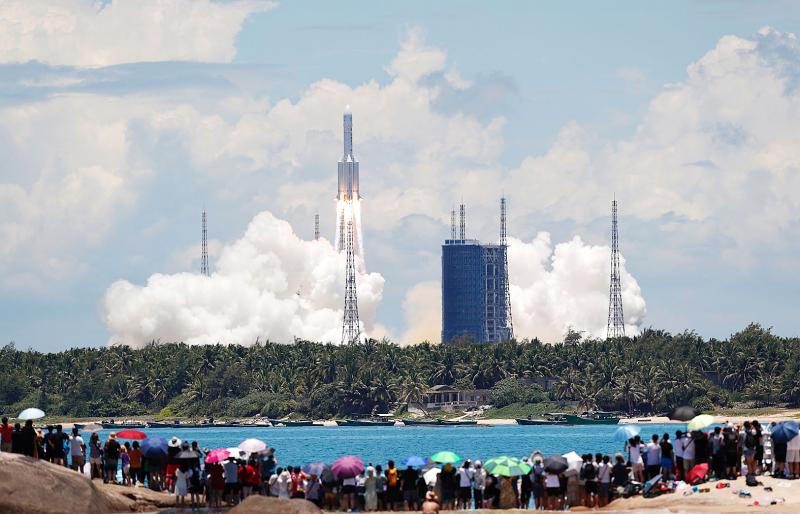China yesterday launched its most ambitious Mars mission yet in an attempt to join the US in successfully landing a spacecraft on the planet.
A Long March-5 carrier rocket took off under clear skies at about 12:40pm from Hainan as hundreds of people watched from a beach across the bay from the launch site.
Launch commander Major General Zhang Xueyu (張學宇) announced to cheers in the control room that the rocket was flying normally about 45 minutes later.

Photo: Reuters
“The Mars rover has accurately entered the scheduled orbit,” Zhang said in brief remarks shown live on state broadcaster China Central Television.
It marked the second flight to Mars this week, after a United Arab Emirates orbiter blasted off on a rocket from Japan on Monday.
The US is aiming to launch Perseverance, its most sophisticated Mars rover ever, from Cape Canaveral, Florida, next week.
China’s tandem spacecraft, which has an orbiter and a rover, is expected to take seven months to reach Mars, like the others.
If all goes well, the Tianwen-1 mission, or “quest for heavenly truth,” is to look for underground water, if it is present, as well as evidence of possible ancient life.
This is not China’s first attempt at Mars. In 2011, a Chinese orbiter accompanying a Russian mission was lost when the spacecraft failed to get out of Earth’s orbit after launching from Kazakhstan, eventually burning up in the atmosphere.
This time, China is going at it alone. It also is fast-tracking, launching an orbiter and rover on the same mission instead of stringing them out.
China’s secretive space program has developed rapidly in recent decades.
Yang Liwei (楊利偉) became the first Chinese astronaut in 2003, and last year, Chang’e-4 became the first spacecraft from any country to land on the far side of the moon.
Conquering Mars would put China in an elite club.
“There is a whole lot of prestige riding on this,” said Dean Cheng, an expert on Chinese aerospace programs at the Heritage Foundation in Washington.
Landing on Mars is notoriously difficult. Only the US has successfully landed a spacecraft on Martian soil, doing it eight times since 1976.
NASA’s InSight and Curiosity rovers still operate today.
Six other spacecraft are exploring Mars from orbit: three American, two European and one from India.
Unlike the two other Mars missions launching this month, China has tightly controlled information about the program — even withholding any name for its rover. National security concerns led the US to curb cooperation between NASA and China’s space program.
In an article published this month in Nature Astronomy, mission chief engineer Wan Weixing (萬衛星) said that Tianwen-1 would slip into orbit around Mars in February next year and look for a landing site on Utopia Planitia — a plain where NASA has detected possible evidence of underground ice.
Wan died in May from cancer.
The landing would then be attempted in April or May, according to the article.
If all goes well, the 240kg golf cart-sized, solar-powered rover is expected to operate for about three months, and the orbiter for two years.

Airlines in Australia, Hong Kong, India, Malaysia and Singapore yesterday canceled flights to and from the Indonesian island of Bali, after a nearby volcano catapulted an ash tower into the sky. Australia’s Jetstar, Qantas and Virgin Australia all grounded flights after Mount Lewotobi Laki-Laki on Flores island spewed a 9km tower a day earlier. Malaysia Airlines, AirAsia, India’s IndiGo and Singapore’s Scoot also listed flights as canceled. “Volcanic ash poses a significant threat to safe operations of the aircraft in the vicinity of volcanic clouds,” AirAsia said as it announced several cancelations. Multiple eruptions from the 1,703m twin-peaked volcano in

China has built a land-based prototype nuclear reactor for a large surface warship, in the clearest sign yet Beijing is advancing toward producing the nation’s first nuclear-powered aircraft carrier, according to a new analysis of satellite imagery and Chinese government documents provided to The Associated Press. There have long been rumors that China is planning to build a nuclear-powered aircraft carrier, but the research by the Middlebury Institute of International Studies in California is the first to confirm it is working on a nuclear-powered propulsion system for a carrier-sized surface warship. Why is China’s pursuit of nuclear-powered carriers significant? China’s navy is already

Chinese President Xi Jinping (習近平) launched a week-long diplomatic blitz of South America on Thursday by inaugurating a massive deep-water port in Peru, a US$1.3 billion investment by Beijing as it seeks to expand trade and influence on the continent. With China’s demand for agricultural goods and metals from Latin America growing, Xi will participate in the APEC summit in Lima then head to the Group of 20 summit in Rio de Janeiro next week, where he will also make a state visit to Brazil. Xi and Peruvian President Dina Boluarte participated on Thursday by video link in the opening

IT’S A DEAL? Including the phrase ‘overlapping claims’ in a Chinese-Indonesian joint statement over the weekend puts Jakarta’s national interests at risk, critics say Indonesia yesterday said it does not recognize China’s claims over the South China Sea, despite signing a maritime development deal with Beijing, as some analysts warned the pact risked compromising its sovereign rights. Beijing has long clashed with Southeast Asian neighbors over the South China Sea, which it claims almost in its entirety, based on a “nine-dash line” on its maps that cuts into the exclusive economic zones (EEZ) of several countries. Joint agreements with China in the strategic waterway have been sensitive for years, with some nations wary of deals they fear could be interpreted as legitimizing Beijing’s vast claims. In 2016,